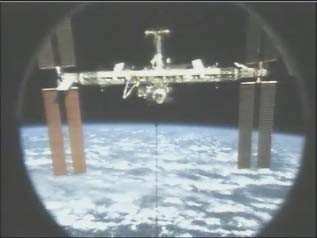Increases Capability To Produce Oxygen, Handle Add'l
Crewmembers
 NASA
says a new oxygen generation system tested between July 11-14
aboard the International Space Station will allow the orbiting
laboratory's crew size to increase in 2009.
NASA
says a new oxygen generation system tested between July 11-14
aboard the International Space Station will allow the orbiting
laboratory's crew size to increase in 2009.
The hardware is part of the station's environmental control and
life support system and will be used to augment the Russian
Elektron oxygen generator. With the increased capability to produce
oxygen, the station can better support six crew members as they
work and live aboard the outpost. The station currently supports a
three-person crew.
During normal operations, the new system will generate about 12
pounds of oxygen per day, enough for six people. However, it can
provide as much as 20 pounds of oxygen per day, enough for as many
as 11 people.
It is designed to replace oxygen consumed through breathing or
lost during experiment use and airlock depressurization. During
last week's test, which started Wednesday and ended Saturday, the
system generated approximately 10 pounds of oxygen.
"The successful activation and operation of this new system
during its test run is an important step toward establishing a
truly International space station," said Mike Suffredini, manager
of the space station program.
"With this system's oxygen-generating capacity, we can expand
the station's crew, providing more opportunities for our partner
countries and unlocking more possibilities for research that will
open new pathways for future exploration."
The 1,800-pound, refrigerator-sized component was delivered on
space shuttle Discovery's STS-116 mission in December 2006 and
installed in the space station's Destiny laboratory. Since then,
several elements of hardware and software have been added to the
station to support the new system's operation. The last required
part, a hydrogen vent valve, was installed during a spacewalk on
space shuttle Atlantis'
STS-117 mission in June.
Work performed by space station Expedition 15 Flight Engineer
Clayton Anderson and software updates to US computers earlier in
July completed preparations for the system's activation and
operation.
 The new system produces oxygen by
tapping into the station's water supply. Through the process of
electrolysis, it splits the water into hydrogen and oxygen
molecules. The oxygen is delivered into the crew cabin, while the
hydrogen is vented overboard through the hydrogen vent valve. In
the future, NASA engineers will recycle the hydrogen for water
production from carbon dioxide.
The new system produces oxygen by
tapping into the station's water supply. Through the process of
electrolysis, it splits the water into hydrogen and oxygen
molecules. The oxygen is delivered into the crew cabin, while the
hydrogen is vented overboard through the hydrogen vent valve. In
the future, NASA engineers will recycle the hydrogen for water
production from carbon dioxide.
Currently, oxygen on the station comes from four sources: the
Russian-built Elektron system, Russian supply vehicles, storage
tanks in the U.S. Quest airlock and solid fuel oxygen generators
called candles.
The new oxygen generation system in the US Destiny laboratory is
one of two primary components in the station's regenerative
environmental control and life support system. The other component,
the water recovery system, is planned to be installed on the space
station in 2008. Periodically, NASA will activate and operate the
new oxygen generator to ensure the system remains ready for its
integration with the water recovery system.
The two new systems were to be included in the space station's
Node 3 module, targeted for launch in 2010. However, mission
managers decided to launch them earlier as part of a strategy to
increase the station's crew to six people in 2009.
 Classic Aero-TV: Extra Aircraft Announces the Extra 330SX
Classic Aero-TV: Extra Aircraft Announces the Extra 330SX Aero-News: Quote of the Day (11.15.25)
Aero-News: Quote of the Day (11.15.25) ANN's Daily Aero-Term (11.15.25): Middle Marker
ANN's Daily Aero-Term (11.15.25): Middle Marker NTSB Final Report: Lancair 320
NTSB Final Report: Lancair 320 Airborne 11.14.25: Last DC-8 Retires, Boeing Recovery, Teeny Trig TXP
Airborne 11.14.25: Last DC-8 Retires, Boeing Recovery, Teeny Trig TXP




